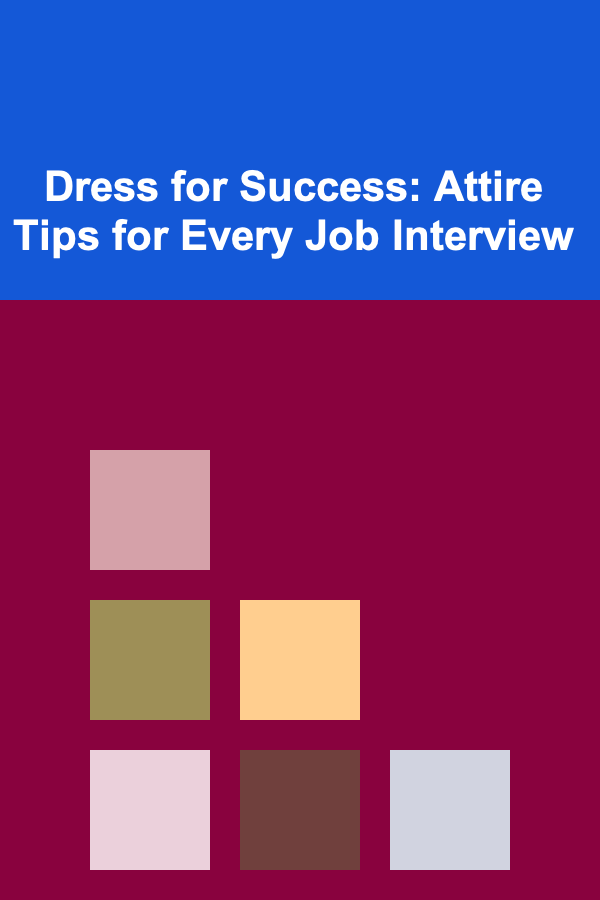
Dress for Success: Attire Tips for Every Job Interview
ebook include PDF & Audio bundle (Micro Guide)
$12.99$6.99
Limited Time Offer! Order within the next:

The old adage "Dress for the job you want, not the job you have" holds true, especially when it comes to job interviews. Your attire plays a pivotal role in the impression you make on potential employers. It's not just about wearing clothes; it's about presenting yourself as a professional who respects the opportunity and understands the expectations of the workplace.
While there is no one-size-fits-all rule when it comes to interview attire, understanding the nuances of what to wear can help you tailor your approach to each unique situation. This guide breaks down the key considerations for dressing for success at any interview and offers actionable tips to ensure that you dress appropriately, feel confident, and make a strong impression.
The Power of First Impressions
The moment you walk into a room, people begin forming opinions about you. The clothes you wear are often the first signal they receive about your professionalism, attention to detail, and understanding of social norms. Even though your qualifications and skills are the most important factors, your attire sets the stage for the conversation that follows. It communicates a lot about who you are, even before you say a word.
A well-chosen outfit is a sign that you are serious about the opportunity. It demonstrates your understanding of the company culture and your ability to align with the professional environment. It shows you are someone who can present themselves with confidence, attention to detail, and an understanding of the professional context in which they operate.
Understanding the Dress Code
When preparing for an interview, one of the first things you should consider is the company's dress code. Companies have different expectations based on their industry, location, and culture. A "one-size-fits-all" approach simply doesn't work. Here's a breakdown of the most common dress codes you'll encounter:
Business Formal
Business formal is the most conservative and traditional dress code. It's typically found in industries such as law, finance, banking, and government. In such settings, the expectation is that you will wear attire that reflects professionalism, respect, and competence.
For Men:
- Suit: A well-tailored, dark-colored suit (navy, black, or charcoal gray) is a must. The suit should fit well but not be too tight or too loose. A slim fit can work if done correctly, but make sure you can move comfortably.
- Shirt: A clean, pressed white or light blue dress shirt. Ensure that it's crisp and neat. The collar should be stiff enough to hold up a tie.
- Tie: A silk tie, preferably in a subtle pattern like stripes or solid colors, works best. Avoid flashy or overly bright colors.
- Shoes: Black or dark brown leather shoes, such as Oxfords, brogues, or derbies. Make sure they are polished and in excellent condition.
- Accessories: Minimalist accessories, such as a classic wristwatch, a tie clip, and a belt that matches your shoes.
For Women:
- Suit: A dark-colored skirt suit or pantsuit. If you opt for a skirt suit, the skirt should fall to the knee or just above it. Pants should be well-fitted but not tight.
- Blouse: A light-colored blouse or shirt in a fabric like silk, cotton, or chiffon. Stick to neutral tones like white, cream, or light blue.
- Shoes: Closed-toe heels or flats in a neutral color. Avoid open-toed shoes or stilettos.
- Accessories: Opt for simple jewelry such as stud earrings, a modest necklace, and a professional handbag or briefcase.
Business Casual
A business casual dress code strikes a balance between formal and casual. It's common in industries such as tech, education, marketing, and even some sectors of the healthcare industry. While business casual offers more flexibility than formal attire, it's still important to present a polished, professional image.
For Men:
- Blazer or Sport Coat: A blazer or a smart jacket paired with dress pants or chinos is a good option. It adds a touch of formality without going overboard.
- Shirt: A collared shirt, either button-down or polo, can work. A dress shirt is a safe choice, but it can be patterned or in a variety of colors.
- Trousers: Chinos or dress pants in neutral colors like navy, gray, or beige are acceptable. Make sure they are pressed and clean.
- Shoes: Leather loafers, brogues, or dress shoes in neutral colors. Avoid sneakers unless you're applying for a very casual or creative role.
- Accessories: A belt matching your shoes, a simple wristwatch, and a tie (optional) can complete the look.
For Women:
- Blouse or Knit Top: A blouse, smart knit top, or a button-down shirt in a neutral color or subtle print. Avoid overly bright or distracting patterns.
- Skirt or Pants: Knee-length skirts or well-tailored trousers work best. A pencil skirt or dress pants are both appropriate.
- Shoes: Closed-toe flats, loafers, or low heels. Avoid open-toed shoes or overly casual footwear like sandals.
- Accessories: Keep accessories simple and professional. A sleek bag, minimal jewelry, and a modest watch are all you need.
Casual
Casual dress codes are more common in industries like tech, design, media, and some start-ups. The goal is to look relaxed yet still put-together, without appearing too laid-back or sloppy.
For Men:
- Shirt: A clean, well-fitted T-shirt or polo shirt in a neutral color or simple pattern. A casual button-down shirt can also work if you want to appear slightly more polished.
- Jeans or Chinos: Dark-wash jeans or chinos are perfect. Avoid distressed, ripped, or overly worn-out jeans.
- Shoes: Sneakers or loafers, depending on the company. Opt for clean, minimal sneakers rather than athletic ones.
- Accessories: Keep accessories simple and minimal---perhaps a watch or a simple bracelet.
For Women:
- Top: A simple blouse, T-shirt, or knit top. Avoid overly casual items like tank tops or sweatshirts.
- Jeans or Trousers: Dark jeans or casual trousers are appropriate. Avoid leggings or overly distressed jeans.
- Shoes: Flats, loafers, or minimal sneakers work well. Avoid sandals unless the company culture is very relaxed.
- Accessories: Stick to minimal jewelry and avoid anything too bold or distracting.
Creative or Fashion-Forward
In creative industries like fashion, advertising, or media, there is often more room for self-expression. However, even in these settings, it's important to dress in a way that shows you understand the professional nature of the workplace.
For Men:
- Shirt: A button-down shirt with an interesting print or color. You can even experiment with textures like chambray or linen.
- Trousers/Jeans: Tailored trousers or dark jeans. Slim cuts are generally acceptable, but the fit should still be neat and clean.
- Shoes: Fashionable loafers, boots, or high-quality sneakers can work. Choose shoes that are clean and in good condition.
- Accessories: Creative yet subtle accessories, such as a statement watch, scarf, or bracelet, can reflect your personal style.
For Women:
- Top: Bold colors, unique cuts, or interesting fabrics can be appropriate in creative industries. A well-fitted blouse or dress can be a perfect choice.
- Bottoms: High-waisted trousers, pencil skirts, or even dark, neat jeans can work well.
- Shoes: Trendy flats, ankle boots, or designer sneakers are acceptable.
- Accessories: This is where you can express your creativity. Unique jewelry, a standout handbag, or a stylish scarf can add a personal touch.
Additional Considerations for Any Dress Code
Regardless of the dress code you are adhering to, there are a few additional guidelines to keep in mind to ensure you present yourself in the best possible light:
1. Fit and Comfort Matter
No matter how stylish or professional your outfit is, if it doesn't fit well, it can quickly undo the impression you're trying to make. Ensure that your clothes are tailored to fit your body type. Avoid clothes that are too tight, too loose, or uncomfortable. The goal is to look neat and well-presented while still feeling comfortable.
2. Grooming is Essential
Appearance goes beyond just clothes---it includes grooming. Ensure your hair is clean, neat, and styled in a professional manner. If you wear makeup, keep it subtle and natural. Trim your nails and avoid overly bright nail polish colors. Ensure that your breath is fresh, and avoid overpowering perfumes or colognes.
3. Pay Attention to Details
Small details can make a significant difference. Ensure your clothes are clean, free of wrinkles, and properly ironed. Avoid wearing clothes with stains, tears, or visible wear and tear. Polished shoes, a neat tie, and a well-chosen watch all contribute to a polished look that shows you've taken the time to prepare.
4. Do Your Research
Research the company culture ahead of time. Check the company website, LinkedIn profiles, or social media platforms to get a sense of the dress code. If you're uncertain, you can always ask the recruiter or HR representative what the expected attire is for the interview.
5. Avoid Overdoing It
While it's important to dress professionally, don't go overboard. Avoid excessive accessories, flashy jewelry, or overly extravagant clothing. The goal is to enhance your professional image---not overshadow it.
Conclusion
Your attire plays a crucial role in setting the tone for your job interview. It shows that you are serious about the opportunity and respectful of the company's culture. By understanding the company's dress code and dressing accordingly, you not only enhance your chances of making a great first impression but also boost your confidence as you enter the interview room.
No matter the industry, whether you're applying for a formal corporate position, a creative role, or a more casual job, dressing thoughtfully is a key part of your strategy. Dress for success, and let your qualifications shine through.
Reading More From Our Other Websites
- [Survival Kit 101] Best Survival Kit for Mountain Bikers Tackling High‑Elevation Trails
- [Beachcombing Tip 101] How to Build a Compact Beachcombing Toolkit for Solo Shore Explorers
- [Home Cleaning 101] How to Remove Pet Odors Naturally From Your Whole House
- [Personal Care Tips 101] How to Use Body Butter for a Deep Moisturizing Nighttime Routine
- [Personal Investment 101] How to Maximize Returns with High-Yield Savings Accounts
- [Home Cleaning 101] How to Declutter and Clean Your Garage for Maximum Storage
- [Small Business 101] How to Optimize Your Small Manufacturing Workflow Using Lean Six Sigma Principles
- [Home Maintenance 101] How to Inspect Your Roof After a Storm and Prevent Future Damage
- [Organization Tip 101] Victorian Home Paint Trends: Top Colors for 2025
- [Home Budget 101] How to Implement Effective Money Management Tips to Build a Robust Emergency Fund

Essential Financial Planning Tools Every Budgeter Should Know About
Read More
How to Optimize Your Oven for Baking and Roasting
Read More
How to Transition Careers: Preparation Tips for a Smooth Shift
Read More
How to Use Financial Ratios to Evaluate Stocks
Read More
How To Discover Advances in Spinal Cord Injury Treatment
Read More
10 Tips for DIY Wedding Decor on a Budget
Read MoreOther Products

Essential Financial Planning Tools Every Budgeter Should Know About
Read More
How to Optimize Your Oven for Baking and Roasting
Read More
How to Transition Careers: Preparation Tips for a Smooth Shift
Read More
How to Use Financial Ratios to Evaluate Stocks
Read More
How To Discover Advances in Spinal Cord Injury Treatment
Read More